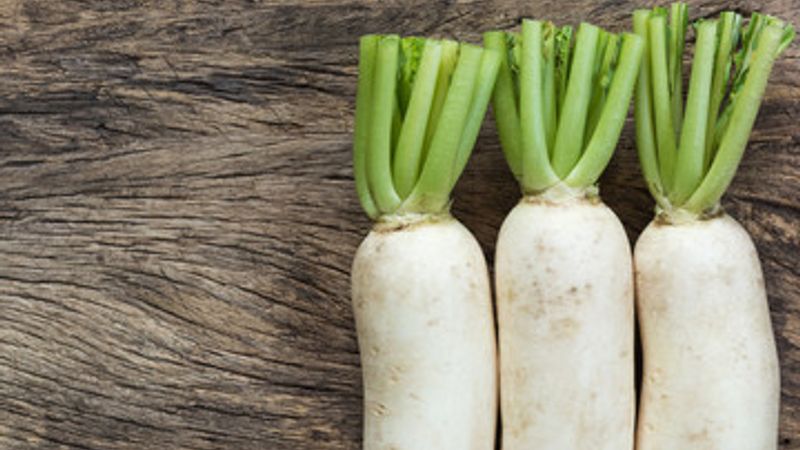

Our Review Process
Our articles undergo extensive medical review by board-certified practitioners to confirm that all factual inferences with respect to medical conditions, symptoms, treatments, and protocols are legitimate, canonical, and adhere to current guidelines and the latest discoveries. Read more.
Our Editorial Team
Shifa Fatima, MSc.
Author
Dr. Apoorva T, MHM.
MEDICAL ADVISOR
Is Radish Good for Diabetes?
Diabetes mellitus is a group of chronic metabolic disorders typified by elevated blood sugar levels. While type 1 diabetes mellitus is characterised by decreased or no production of insulin by the pancreas, type 2 diabetes mellitus is concerned with insulin resistance, a condition in which cells do not respond to insulin adequately. Apart from drugs, eating a healthy diet composed of vegetables, fruits, grains, proteins, etc., is critical for the long-term management of diabetes mellitus.
Radishes are a group of root vegetables that are consumed across the globe. Radishes are an excellent source of vitamins, minerals, fiber, proteins, etc. Radishes are a low-calorie vegetable that has been shown to have protective functions in diabetes. This article will discuss the nutritional profile of a radish, why radish is good for diabetes, how it can be consumed, and other details. Read more to know about is radish good for diabetes?

Table of Contents
Glycemic Index of Radish
Radish is low in Glycemic index (GI). The GI of a food indicates how quickly it can raise blood sugar levels after consumption. Foods can have a GI value ranging from 0 to 100. Foods with GI values less than or equal to 55 are considered low, and radish has a GI value of around 32.
Nutritional Profile
Radish is low in carbs and calories, making it a good food choice for people trying to normalise their blood sugar levels. About one cup of radish amounts to 19 calories and 4 grams of carbohydrates. Radish is also a rich source of natural antioxidants like vitamin C, and one cup of radish provides almost 29 % of recommended daily allowances (RDA) of vitamin C. The nutrients and their quantities present in 100 grams of radish are tabulated below:
Radish Benefits for Diabetes
- Radish has a low Glycemic index (GI). GI measures how quickly a food can elevate blood sugar levels after consumption. Foods can have a GI value between 0-100. Foods having GI values less than or equal to 55 are considered low, and radish has been shown to have a GI value of about 32.
- Radish contains phytochemicals like isothiocyanate and glucosinolate that aid in regulating blood glucose levels.
- Consuming radish has also been shown to increase the production of adiponectin. Adiponectin is a hormone that protects cells against insulin resistance.
- Apart from Vitamin C, radish also contains other antioxidants like coenzyme Q10, which scavenges free radicals and protects patients against complications associated with diabetes mellitus.

Ways to Consume Radish for Diabetes
You can consume radish in many ways. Here are some ways to consume radish-
- Radish can be consumed as part of a salad.
- They can be taken in the form of a radish soup or can be added to stews.
- They can be added to a sandwich or burger.
- They can be blended and be consumed as juice before your meals.
- Radish can be roasted in the oven by drizzling olive oil over them. Also know about diabetes diet chart indian.
Best Time to Eat Radish
Radish can be taken as part of a meal or taken as a snack. Radish has soothing properties, and therefore consuming them at night may aid in sleeping. There is no best time to consume radish, and they can be eaten as you please! Also know how to get freedom from diabetes?
Risks of Overconsumption of Radish
- Overconsumption of radish can lead to bloating in certain individuals.
- Excess consumption leads to abdominal pain and diarrhea.
- Individuals with hypothyroidism or Hashimoto’s disease must keep their radish intake to a minimum since radish contains phytoconstituents that reduce thyroid hormone secretion.
Also know more about diabetes diet chart.
Other Health Benefits of Eating Radish
- Hepatic system: Radish contains compounds like 4-methylthio-3-butenyl-isothiocyanate and indole-3-carbinol that help in liver detoxification.
- Cardiovascular system: Radish is a good source of antioxidants that aid in scavenging free radicals. Micronutrients present in radish-like potassium and calcium help in regulating blood pressure. These nutrients decrease the risk of developing heart diseases. Additionally, radish also contains nitrates that contribute to improved blood flow.
- Apart from the protective effects on hepatic and cardiovascular systems, radish consumption helps in improving lipid metabolism and reduces the risk of urinary tract infections.
Understanding sugar free, No Added Sugar ,and Unsweetened
Bottomline
Radish has an abundance of micronutrients, and its low-calorie content makes it a good food for people trying to reduce weight. It is low in carbs, high in fiber, and is a low GI food. All these, combined with their protective action in diabetes, make it an excellent vegetable to be included in the diet of people with diabetes. It also has protective functions on hepatic and cardiovascular systems. Radish can be taken as part of a salad or consumed as a soup or juice. However, overconsumption of radish should be avoided as it can lead to bloating and other abdominal problems.
FAQs
Is radish good for diabetes ?
Radish has been shown to have anti-diabetic properties, making it beneficial for diabetics.
Are radishes good for type 2 diabetes?
Yes, radish is a good food to include in the diet of diabetics. Radishes are a low-carb and low-calorie vegetable that is high in vitamins and minerals and helps to keep your blood glucose levels stable.
References
- https://www.webmd.com/diet/health-benefits-radish
Disclaimer
This website's content is provided only for educational reasons and is not meant to be a replacement for professional medical advice. Due to individual differences, the reader should contact their physician to decide whether the material is applicable to their case.








